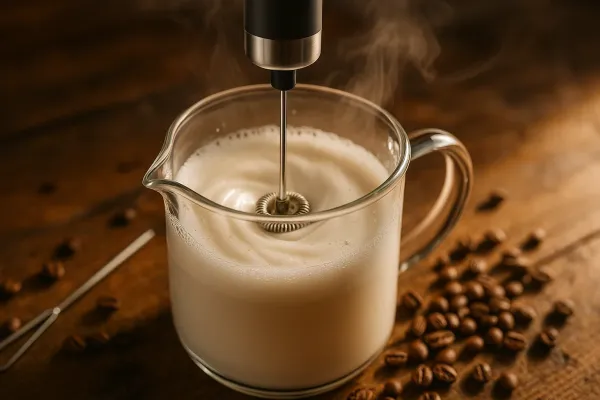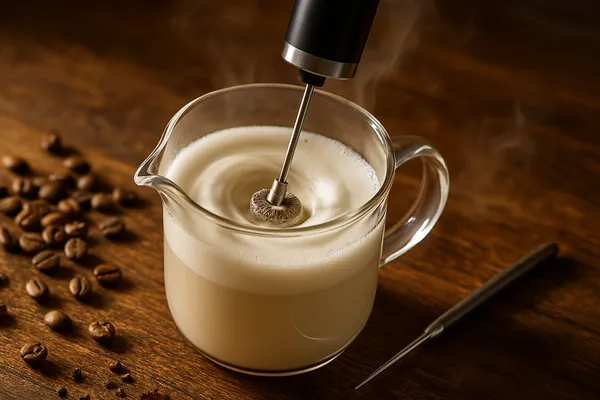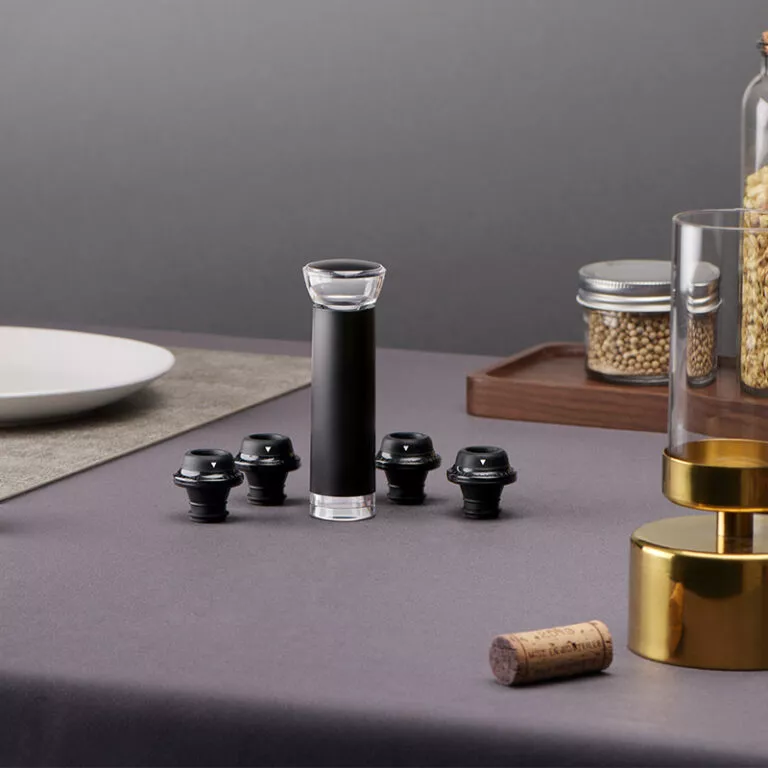Are you tired of dull homemade coffee? I was, too. I found a clever tool to make creamy foam, and now everything tastes better.
Yes, a milk frother is worth it. It creates a rich foam for lattes, cappuccinos, or hot chocolate. It also upgrades everyday coffee into a café-style treat. Enjoy smoother textures and a cozy vibe.

I used to drink flat, lifeless coffee at home. Then I discovered how simple it is to elevate any cup of joe with frothed milk. It quickly adds a layer of indulgence that makes a big difference. Let’s explore the key reasons to get a milk frother and answer common questions about its benefits and uses.
What’s the point of frothing milk?
I used to wonder why my lattes never matched what I had in cafés. Then I realized the secret was simple: frothed milk.
Frothing milk adds volume and texture. It makes coffee feel luxurious. The foam holds flavor and aroma. It also creates a smooth mouthfeel.

Why Texture Matters
Many people think milk is just a sidekick to coffee. But milk carries fats, proteins, and sugars that can interact with coffee’s natural acids. When you froth milk, you infuse it with air. This creates microbubbles that change the milk’s body. Those bubbles give a sweet, creamy sensation that balances the bitter edge of espresso. They also hold onto aroma molecules, so each sip has more flavor.
I tried using plain milk in my coffee for years. The taste was fine, but it never felt special. When I started frothing, I realized there was a new layer of enjoyment. The foam feels light, yet it enriches the drink in ways plain milk cannot. It also helps preserve the heat of the beverage. That’s a small detail, but it’s nice when you’re sipping slowly.
The Science of Froth
Frothing involves mechanical agitation. This process unfolds the protein structures in milk, allowing them to trap air. The proteins stabilize those tiny bubbles. Fats add creaminess. Sugars enhance sweetness. A good froth strikes a balance among these components. This synergy is why cappuccinos and lattes feel more luxurious than a simple cup of coffee with cold milk.
Below is a quick comparison of common frothing results:
| Frothing Approach | Foam Density | Flavor Enhancement | Typical Use |
|---|---|---|---|
| Lightly Frothed | Mild | Subtle Sweetness | Flat Whites, Cafe Au Lait |
| Heavily Frothed | Thick | Strong Creaminess | Cappuccinos, Macchiatos |
I learned that achieving the right foam requires practice. Small differences in technique, milk temperature, and frother speed can change outcomes. But once you get the hang of it, you can tailor your foam to match your favorite style. This flexibility makes a milk frother invaluable if you enjoy experimenting with coffee drinks. You can even expand beyond coffee and froth milk for hot chocolate or tea lattes. All these perks make frothing a key element of café-style beverages. It’s not about complicating your routine. It’s about bringing a simple but effective trick into your home.
Are handheld milk frothers any good?
I hated lumps in my morning coffee. That frustration led me to try a handheld frother1. I didn’t realize how it could change my routine.
Handheld frothers are quick, portable tools. They spin at high speed to mix air into milk, forming foam in seconds. They are good for small servings and easy cleanup.

Exploring Handheld Benefits and Drawbacks
Handheld frothers look like small wands with a whisk at the end. They run on batteries or plug into a power source. You dip the whisk into a cup of milk and turn it on. Within seconds, you see foam building up. I was skeptical at first. I assumed they were gimmicky gadgets. But after trying one, I saw how convenient they can be for single servings.
Pros of Handheld Frothers
- Portability: They are easy to move around the kitchen. They also fit in a drawer without taking too much space.
- Affordability: Most handheld frothers cost less than big electric milk frothers. They’re a good entry point.
- Simple to Clean: You can rinse the whisk under running water. There are fewer parts to disassemble.
- Quick Operation: They foam milk in under a minute, perfect for busy mornings.
Cons of Handheld Frothers
- Limited Volume: They struggle with larger quantities of milk. Frothing cup by cup can be slow if you have many guests.
- Manual Effort: You must hold and guide the frother, which can lead to inconsistent results if you rush.
- Battery Dependence: If it’s battery-powered, you risk running out of juice mid-foam. That once happened to me, and it was annoying.
Below is a simple table comparing handheld frothers to countertop electric frothers:
| Feature | Handheld Frother | Electric Frother |
|---|---|---|
| Size | Compact | Larger footprint |
| Capacity | 1 cup at a time | Often multiple servings |
| Consistency | Depends on your technique | More uniform results |
| Price Range | Low to Moderate | Moderate to High |
| Cleanup | Quick rinse | Might have more parts to wash |
I used a handheld frother for a while before switching to a larger electric model. The handheld version was perfect when it was just me. I could create a nice foam for my morning latte in under 30 seconds. However, when I hosted brunch, it took too long to froth multiple servings. That’s when I realized each device has its place. If you value simplicity and have minimal space, a handheld frother is a great pick. If you want to serve multiple people or prefer automated results, a countertop frother might suit you better. In the end, handheld frothers are definitely “good,” but their effectiveness depends on how you plan to use them.
Does frothed milk taste different?
I used to think milk was milk. Then I discovered frothed milk2. My taste buds changed.
Frothed milk has a lighter, sweeter taste. The added air changes how the milk meets your tongue. It enhances the coffee’s flavors without overpowering it.

How Frothing Alters Flavor
Air bubbles don’t just change texture. They also shift how you perceive sweetness. When milk gets aerated, lactose and other sugars can become more noticeable. This effect often makes the beverage taste milder or slightly sweeter, even if no extra sugar was added.
I noticed this the first time I frothed milk for hot chocolate. The foam gave each sip a silky layer. The chocolate flavors seemed more intense, yet not cloying. I later learned this is because foam lifts volatile compounds to the surface, making aromas more pronounced. You get a fuller sense of the flavor with every sip.
Mouthfeel Matters
The “mouthfeel” of frothed milk is also key. Dense foam can create a velvety sensation that contrasts with the stronger coffee flavors beneath. Lighter foam adds a playful, airy note. Experimenting with these textures can make your drinks more exciting. I discovered I prefer a medium-density foam for my daily latte. It feels creamy but doesn’t overshadow the espresso.
I also found that frothed milk pairs well with teas. Matcha lattes, for instance, become smoother and more balanced. Even herbal teas can benefit if you want a richer, more comforting mug. The difference in taste stems from how frothing changes milk’s structure at a microscopic level. It’s not just air in milk; it’s a transformation that tweaks how flavor molecules interact with your tongue. That’s why you’ll hear many café owners rave about the importance of properly frothed milk. Once you try it, you realize your beverage is no longer flat. It has layers, both in flavor and texture, that plain milk never provided.
What is the best milk for frothing?
I once made froth that disappeared fast. I realized the milk type was the culprit. Now I know how to pick the right milk.
Dairy milk with higher protein and fat froths well, like whole or 2%. Non-dairy alternatives vary. Oat milk can produce creamy foam, while almond milk can be less stable.
Choosing the Perfect Milk
Milk choice can make or break your foam. Whole milk has a good balance of protein, fat, and sugars, which helps create stable froth. Low-fat milk still froths, but the resulting foam can be lighter and less creamy. Skim milk can form large, airy bubbles, though the flavor might be less rich.
Understanding Milk Components
- Protein: Helps stabilize foam. More protein often leads to more substantial froth.
- Fat: Adds creaminess and body. Whole milk gives a velvety texture that many people love.
- Sugars (Lactose): Enhance sweetness when air is introduced.
Below is a table comparing popular milk options for frothing:
| Milk Type | Foam Stability | Flavor Richness | Frothing Difficulty |
|---|---|---|---|
| Whole Milk | High | Creamy, smooth | Easy |
| 2% Milk | Moderate | Less creamy | Moderate |
| Skim Milk | Low | Light taste | Can be foamy but thin |
| Oat Milk | High (depends on brand) | Sweet, creamy | Fairly easy if it’s a barista-style version3 |
| Almond Milk | Variable | Nutty, lighter | Can separate if overheated |
| Soy Milk | Moderate | Mild sweetness | Works well, but watch temperature |
I once tried a generic brand of almond milk, hoping to make a great latte. The foam vanished fast, leaving me with a flat drink. Then I experimented with oat milk labeled “barista edition.” It frothed almost like dairy milk. That showed me how not all plant-based milks are equal. Some are formulated to handle higher temperatures and foam better.
Tip: Check the label for “barista” or “for frothing” if you want plant-based milk. Those versions often contain added stabilizers or slightly different formulations that allow them to foam more like dairy milk. Also pay attention to temperature. Overheating can break down proteins, causing foam to collapse. Aim for a range of around 140–150°F (60–65°C) for the best results. For me, that sweet spot ensures stable foam without scorching the milk. Once you find your favorite milk, you can enjoy consistent foam and a richer overall flavor in every cup.
Conclusion
A milk frother transforms plain coffee into a foamy treat. It makes homemade beverages taste better, feel more luxurious, and keeps your routine simple. It’s a small upgrade that brings big satisfaction.
-
Discover the advantages of handheld frothers and how they can enhance your coffee experience with convenience and ease. ↩
-
Explore how frothed milk enhances flavors and textures in drinks, making them more enjoyable and complex. ↩
-
Find out why barista-style milk is specially formulated for frothing and how it can enhance your coffee drinks! ↩




